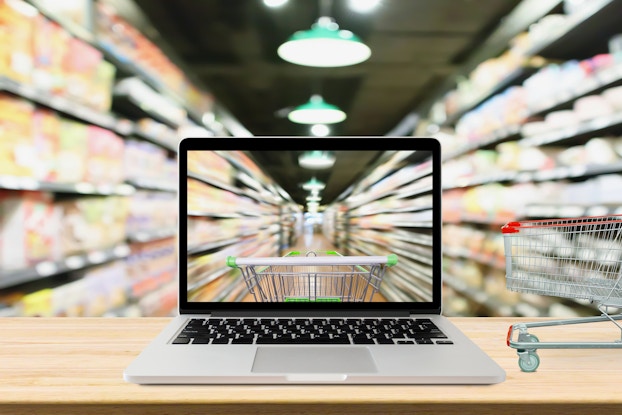
Ignore the headlines that scream grocery stores are becoming extinct due to the battle between online and brick-and-mortar grocery retailing. They’re not true.
What is true is that online is now the fastest-growing grocery retail channel, with a compound annual growth rate of 19.5%, according to the grocery retail research firm IGD.
But despite that double-digit growth rate, online still represents only 2% to 5% of the $743 billion U.S. grocery retail market, according to CBRE Research.
The truth is that grocery stores are in a new period of vibrant growth, fueled in part by the rise of organic fare, healthy options and specialty items in the aisles, as well as innovations like prepared foods and meal kits.
Against that backdrop, online isn’t replacing grocery stores. Instead, it’s augmenting them akin to how the addition of in-store pharmacies and bakeries brought features to supermarkets that didn’t exist before. Similarly, online grocery is more of a feature rather than a standalone business, and an increasingly important convenience tool when it comes to supermarket shopping, sources said.
New data from IGD provides strong evidence the rumors about online grocery dethroning brick-and-mortar grocery retailing anytime soon — or if at all — are greatly exaggerated.
(Amazon knows this, too, which is why it acquired Whole Foods Market and is building even more brick-and-mortar stores.)
The U.S online grocery market was $23.9 billion in 2018, and IGD predicts it will grow to $59.5 billion by 2023, which still leaves it with less than 10% of the overall grocery retail channel five years from now. If that forecast comes true, the brick-and-mortar grocery retail channel will still be far from extinct in 2023, with an over 90% share of the more than $700 billion grocery sales pie.
Online to catalyze grocery-shopping convenience, as stores remain king
Retail industry analyst Neil Stern, senior partner at McMillanDoolittle LP, agrees with this forecast. Stern told CO— he predicts online grocery could range from 10% to 15% of overall retail grocery sales 10 years from now.
“Those numbers will come from a combination of third-party fulfillment [via brick-and-mortar retailers] from providers like Instacart, retailer direct delivery and ordering online and picking up in-store,” Stern said. “There are still some basic economic hurdles to selling groceries online. It really is hard to do so profitably, which is why we are only at 2% to 3% of sales today.”
Rather than a massive sales funnel, online will serve to bring heightened convenience to grocery store shopping. That’s where online is going — third-party fulfillment, retailer direct delivery, online ordering with in-store pick up, which all have retail stores as their source, as opposed to pure-play e-commerce grocers, Stern said.
Further evidence brick-and-mortar grocery will continue to rule the roost over online for the foreseeable future comes from a new report by JLL Retail, which found that new grocery store openings were up a whopping 30% in 2018, with more than 17 million square feet of space added in the U.S.
“Grocery is one of the strongest retail sectors in the U.S., with nearly twice as many new stores opening than closing last year,” James Cook, director of retail research at JLL, told CO—. “Grocers are plunging significant amounts of capital into perfecting the online experience for shoppers, while also ensuring that stores remain easy to navigate and provide an enjoyable retail experience. It’s not just about in-store or online experience, it’s about providing flexible and reliable options for customers no matter how they want to shop.”
Grocery is one of the strongest retail sectors in the U.S., with nearly twice as many new stores opening than closing last year.James Cook, director of retail research at JLL
Sell More
The grocery industry shows higher sales in brick-and-mortar stores than it does online. Curious to know if your customers prefer online or in-person? Read more here.
Americans say they like grocery stores too, which helps explain this growth. A new study by retail research firm Walker Sands concluded that when it comes to online retail, grocery shoppers remain laggards.
The survey of over 1,600 consumers found that only 11% have ordered a food item from Amazon, the leading U.S. online grocer, while 82% said they made purchases in a physical grocery store in the past year, said Erin Jordan, retail technology and commerce practice area lead at Walker Sands and author of the report. Additionally, only 9% reported they’ve ordered online and picked up groceries in-store, strongly suggesting they prefer the experience of in-store shopping, she said.
“Grocery customers still prefer brick-and-mortar grocery stores to online,” said Kurt Jetta, president and founder of Shelton, Conn.-based retail research firm TABS Analytics.
A recent Tab’s Analytics survey of 1,000 U.S. adults found that 75% cited traditional grocery stores and 57% named Walmart as the retail venues they regularly visit (more than six times per month) to buy groceries.
Conversely, “Online was cited by just 17% of respondents — one in six consumers — as a regular grocery shopping outlet,” Jetta said. That’s a 4% increase over a survey the firm conducted in 2017, according to Jetta, “but still only 38% of consumers said they’ve made purchases online even once, and 62% still buy no food or beverages online,” he said.
Jetta, whose firm examines online grocery using a variety of research modalities, said he’s concluded online will never exceed 20% of the total U.S. grocery retail market.
“The best results we see are for non-food categories such as vitamins and cosmetics, and their online share appears to have hit the ceiling at around the 20% level,” he said. “Our data shows that repeat rates for online grocery are not high enough to sustain a given share level over the long term. Growth is based on positively replenishing their share base (gaining more than they lose) and our data suggests online’s share could actually start moving down over the next two to three years.”
In a report released in June 2019, Food in Demand: Grocery, CBRE found that grocery retail sales will grow steadily over the next five years, and Melina Cordero, CBRE’s global head of research, said, “The store will remain central to the grocery industry.”
CBRE reported that grocery sales across all retail channels, from conventional supermarkets to club stores, totaled $743 billion in 2018, up 3.5% from the previous year.
Online grocery as a share of total grocery retail will reach 5% to 10% by 2022, altering, but far from replacing, physical stores.
Echoing Jetta’s analysis, CBRE’s Cordero said, “Although online grocery share will grow over the next five years, the costs and operational challenges of food logistics will keep it lower than the online share in most other retail categories.”
CO— aims to bring you inspiration from leading respected experts. However, before making any business decision, you should consult a professional who can advise you based on your individual situation.
CO—is committed to helping you start, run and grow your small business. Learn more about the benefits of small business membership in the U.S. Chamber of Commerce, here.







